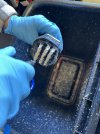Affinity
Well-Known Member
Donator
Full Member
- Messages
- 6,948
- Reaction score
- 1,062
Best CYA advice is to do research and follow State and local guidance for proper Hazmat disposal.


Best CYA advice is to do research and follow State and local guidance for proper Hazmat disposal.


This is how its done.

THAT is exactly what they're doing with the East Palestine "clean-up". Curious how they had to ship it to Pennsylvania, Michigan and Indiana. But hey, the EPA says the air is ok (in spite of independent laboratory testing coming up toxic),so what's the big deal?Were all doomed. Hooray technology! Do you think a recycling facility doesnt just take your money and drive it to the landfill?
Not likely. The "green" movement at the celebrity level is all about the green ($$$$),and she'd not be welcome in fly over country anyway.Any sign of Greta?
She’ll be at the SVB protest though.Not likely. The "green" movement at the celebrity level is all about the green ($$$$),and she'd not be welcome in fly over country anyway.
This sounded like a great idea. We bought a couple of 1/2 gallon jars with screw-on lids, filled them with dirty IPA and left them in a room with lots of windows (not necessarily in direct sunlight). Three weeks later the jars are full of a kind of gelatin. Nothing has completely hardened and no clear IPA has risen to the surface. We've just got a couple jars of unusable goo. What am I missing?Pour it in a clear container and place it in direct sunlight. This will cure the resin making it sink to the bottom leaving fresh alcohol on top for you to reuse.
We just started doing this.This sounded like a great idea. We bought a couple of 1/2 gallon jars with screw-on lids, filled them with dirty IPA and left them in a room with lots of windows (not necessarily in direct sunlight). Three weeks later the jars are full of a kind of gelatin. Nothing has completely hardened and no clear IPA has risen to the surface. We've just got a couple jars of unusable goo. What am I missing?
Same hereWe just started doing this.
First we leave the plastic containers in direct sunlight. Then we let the mix of gelatin and alcohol sit for a few days indoors and the gelatin will start to settle at the bottom but still wont harden. Then after a few days we filter it and it separates the gelatin part from the alcohol.
The gelatin definitely still contains a lot of alcohol but at least we are disposing of less alcohol than before. You can leave the gelatin in an open container so the rest of the alcohol evaporates and the gelatin hardens.


If you place your old ISP alcohol in direct sunlight it will further cure and deposit old resin to the bottom hence you can re-use isp, just siphon of the good and discard the minimal sludge. I've seen a recommendation to add 25% more ISP to that mixture after that process.I haven't really seen this discussed before
What are you guys doing to the used isopropyl alcohol that was used to clean resin from 3D printing?
I have read it can be quite harmful if disposed down the drain or in the trash bin.

